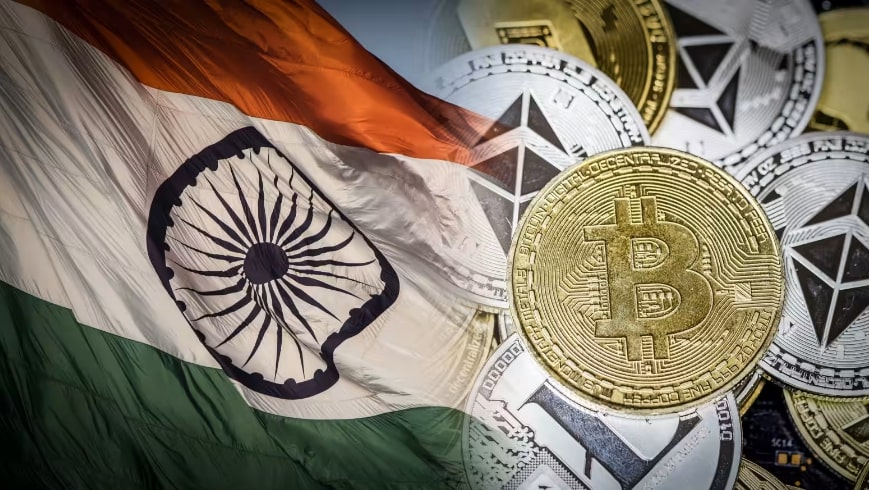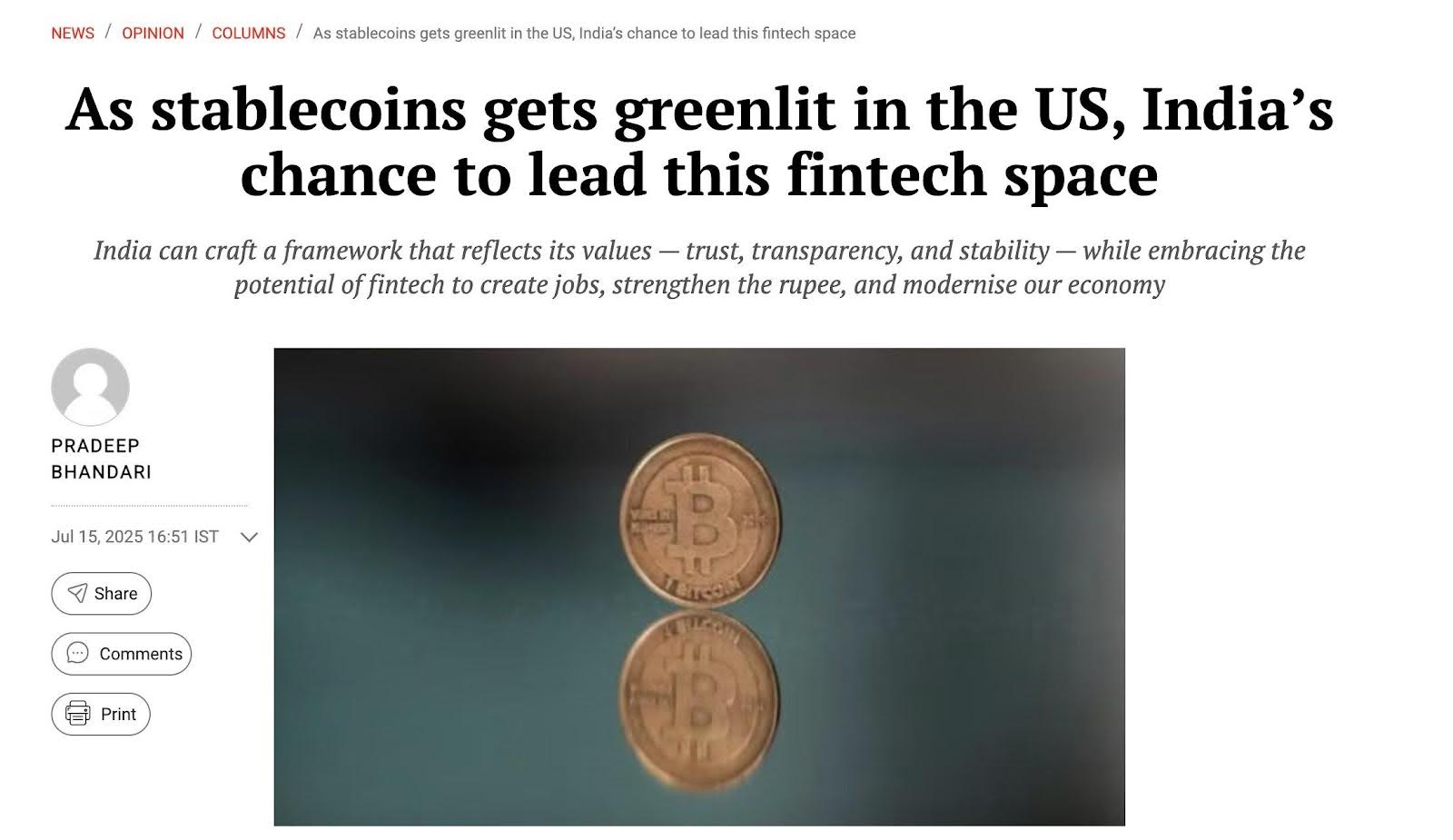India’s $1 Trillion Crypto Opportunity: CoinDCX CEO Calls for Bold Web3 Action Now

Key Takeaways:
- CoinDCX CEO Sumit Gupta backs BJP’s pro-stablecoin stance, calling crypto a $1T GDP catalyst for India.
- Gupta urges India to implement Web3 regulation or risk losing talent and capital to crypto-friendly countries.
- With the U.S. passing pro-stablecoin laws, India faces urgent pressure to lead in blockchain innovation.
India’s nascent crypto ecosystem is standing at a crossroads. As world powers including the U.S. double down on regulated stablecoins, Indian Web3 leaders are raising the alarm: Act now or lose the trillion-dollar opportunity. One of the Indian crypto community’s loudest voices, CoinDCX CEO Sumit Gupta, has publicly commended the BJP’s support for stablecoins and the role they could play in unlocking huge levels of economic growth.
Read More: India’s Supreme Court Registers Landmark Crypto Petition Amid Legal Uncertainties

Sumit Gupta’s Endorsement: Web3 as India’s GDP Engine
Sumit Gupta, co-founder and CEO of CoinDCX, took to X (formerly Twitter) on July 16 to highlight a powerful op-ed written by Pradip Bhandari, a national spokesperson for the ruling Bharatiya Janata Party (BJP). The op-ed argued that stablecoins, digital currencies pegged to fiat could play a pivotal role in positioning India as a global fintech superpower.

Gupta supported the message, stating:
“The Web3 ecosystem has the potential to add $1 Trillion to India’s GDP by 2032. Countries around the world are drafting frameworks and developing their ecosystems, it is time for India to act too!”
He also applauded Bhandari’s piece for illustrating how stablecoins enhance the global fintech ecosystem and create new pathways for growth, capital access, and digital inclusion.

This tweet if anything is a campaign, and that campaign is returning full gallop inside India’s crypto industry: without proactive legislation, the country looks set to fall far behind in the next generation of digital finance.
Global Context: U.S. Regulatory Moves Raise the Stakes
The timing of Gupta’s call to action is not coincidental. Just weeks before, the U.S. had passed the GENIUS Act, which allowed regulated entities — like JPMorgan and Amazon — to issue tokenized dollars backed by U.S. Treasury assets at a 1:1 ratio.
Passed with bipartisan backing, the bill aims to produce a strong, regulated framework for stablecoins to interoperate with the traditional financial system. U.S. Treasury Secretary Scott Bessent described the legislation as a national economic strategy, saying:
“Stablecoins could end up being the largest buyers of U.S. Treasury Bills.”
This level of institutional and regulatory alignment has solidified the U.S. as a frontrunner in Web3 adoption.
India, in contrast, has yet to define a clear regulatory path for stablecoins. The Reserve Bank of India (RBI) remains cautious, citing concerns about monetary control. However, as Bhandari argued, these concerns can be addressed with rupee-backed stablecoins issued under a sovereign, transparent framework.
India’s Digital Foundation Is Ready but Web3 Needs Policy
India already boasts one of the world’s most advanced digital infrastructures. Unified Payments Interface (UPI), Aadhaar digital identity, and ONDC (Open Network for Digital Commerce) have revolutionized digital interaction at scale.
But Gupta and other industry voices argue that the next phase. Web3 infrastructure, is missing the regulatory clarity needed to thrive.
“India has built the digital rails. Now it’s time to run high-speed trains on them,” said a Mumbai-based blockchain entrepreneur in response to Gupta’s post.
Developers, founders, and institutional investors in India continue to operate under a cloud of legal uncertainty. Without a well-defined crypto policy, many are setting up operations in Dubai, Singapore, or the U.S., which offer tax clarity, licensing pathways, and government support for blockchain initiatives.
The Cost of Inaction, Brain Drain and Capital Flight
Lack of policy doesn’t just slow innovation, it drives it away.
Several Indian Web3 startups have moved headquarters offshore in the past two years. The founders of Polygon, once India-based, now operate across Dubai and the U.S. Numerous DeFi protocols and NFT platforms built by Indian developers are legally registered outside the country to avoid domestic uncertainty.
The consequence? India is losing out on:
- FDI (Foreign Direct Investment) in Web3 infrastructure
- Job creation in blockchain development and compliance
- Tax revenue from crypto projects that could’ve been based onshore
Gupta and Bhandari’s comments stand as a shared warning: absent regulatory clarity, India will further hemorrhage talent and capital to more open-minded jurisdictions.
Why Stablecoins Matter for India’s Economic Playbook
Stablecoins are not just crypto tools but are also a link between traditional finance (TradFi) and decentralized finance (DeFi). For a country such as India, where inclusion is extremely fundamental to the country’s economy in terms of reversible remittance flows, there are several issues that can be solved with the use of regulated stablecoins:
- Instant, low-fee cross-border payments for the $100B+ remittance market
- Tokenized savings products integrated with UPI
- Digitally native bonds issued on-chain by government entities
- Rural and small-business lending via programmable stablecoin smart contracts
According to a 2024 study by Chainalysis, India ranks first globally in grassroots crypto adoption but lacks formal infrastructure. Regulated stablecoins would give users a legally compliant entry point into Web3, without the volatility of traditional crypto assets.
Read More: MEXC Sparks Massive Web3 Surge in India with Title Sponsorship of 2025 Blockchain Tour
The post India’s $1 Trillion Crypto Opportunity: CoinDCX CEO Calls for Bold Web3 Action Now appeared first on CryptoNinjas.
